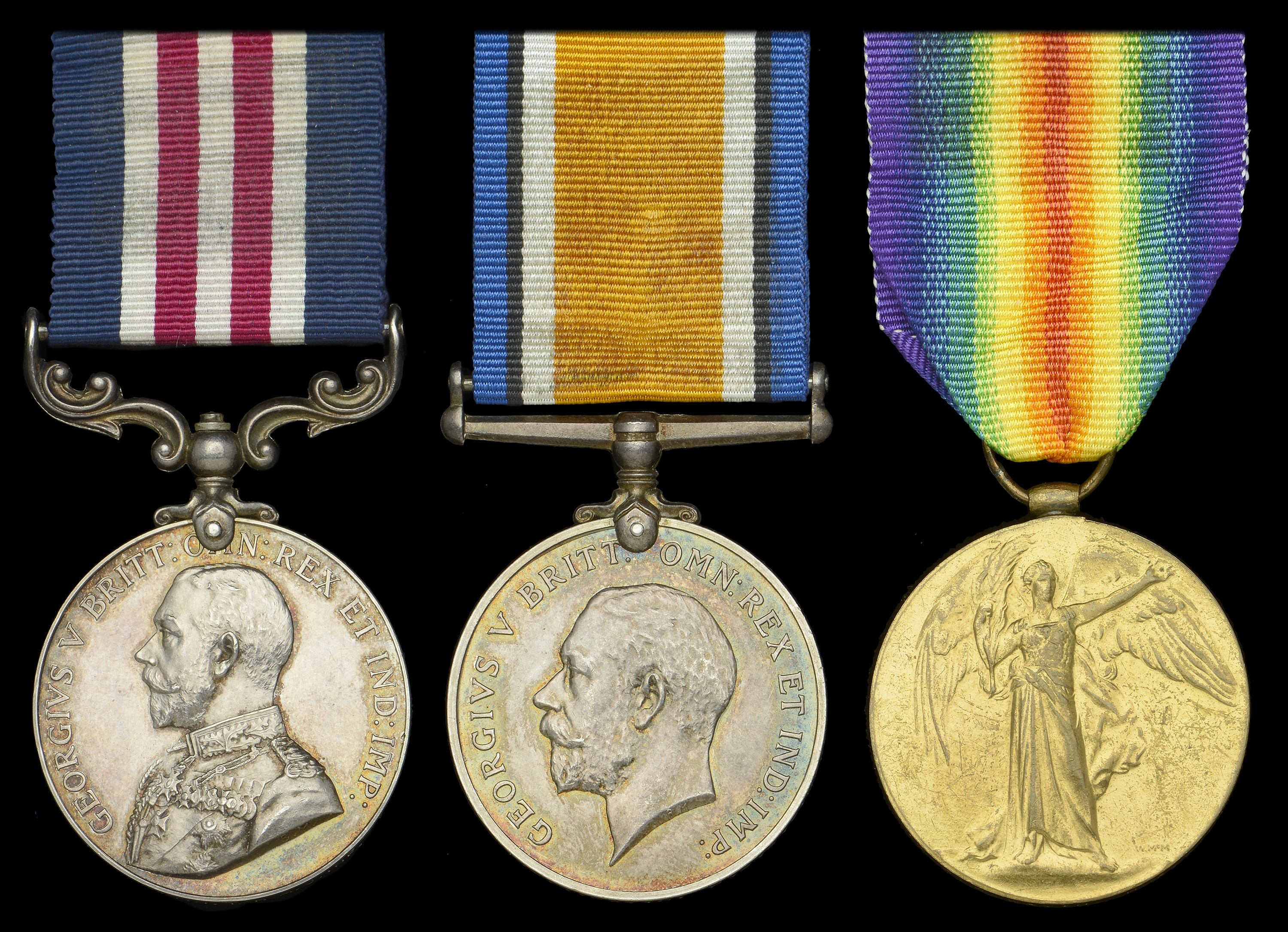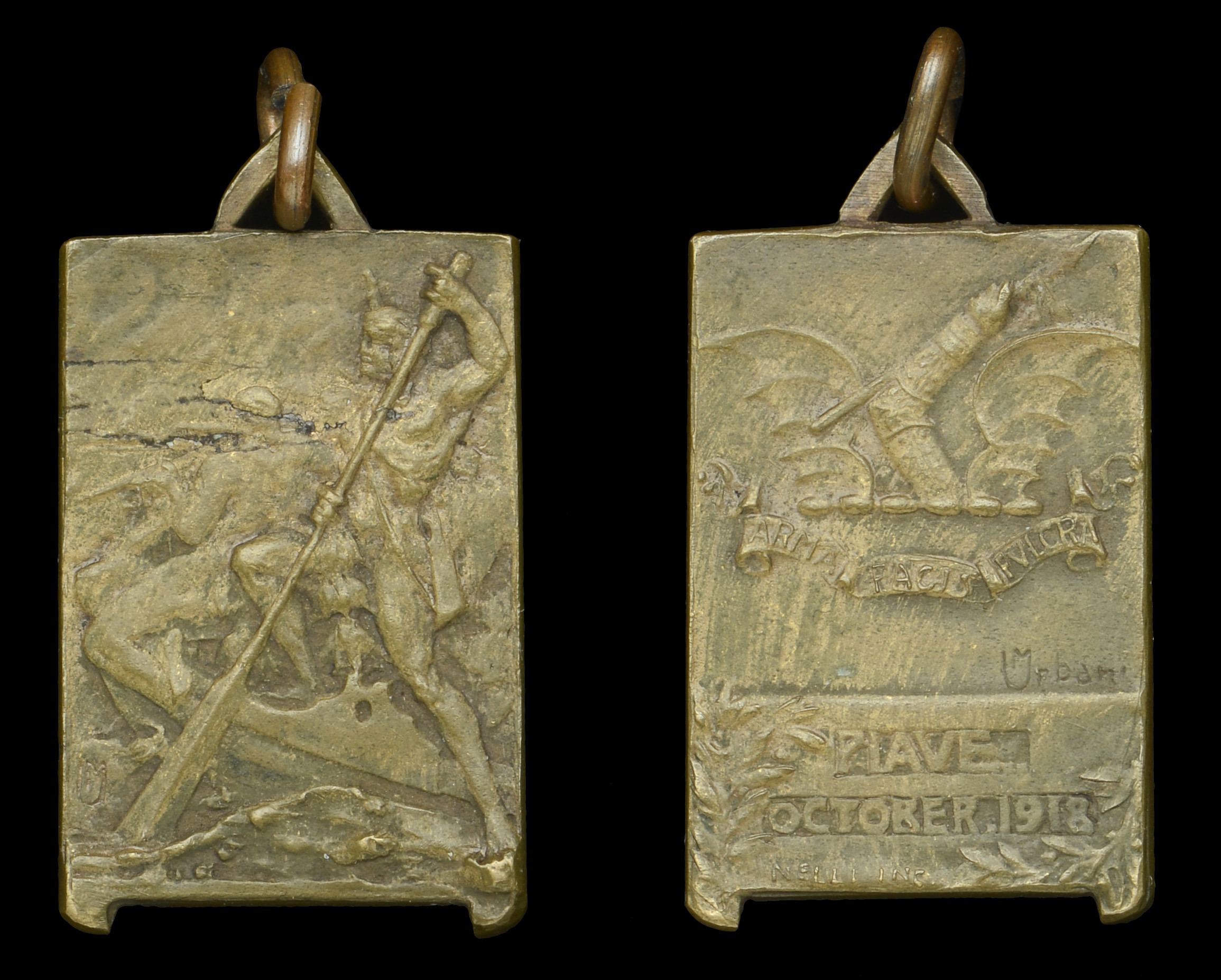A Great War 1918 Italian Theatre ‘Piave Operations’ M.M. group of three awarded to Private C. S. Gavin, Honourable Artillery Company, who was decorated for his gallantry at the capture of the Island of Papadopoli, 25-26 October 1918 Military Medal, G.V.R. (10754 Pte. C. S. Gavin. 1/H.A.C. Inf.); British War and Victory Medals (10754 Pte. C. S. Gavin. H.A.C. - Inf.) together with a small Bronze medallion ‘Presented by the Italian government to all members of the 2nd Battalion, Honourable Artillery Company for the Crossing of the Piave, October 1918’, good very fine (4) £400-£500 --- M.M. London Gazette 29 March 1919 Crichton Strachan Gavin was born in 1884 at Gillingham, Dorset. A bank clerk by profession, he attested for the Honourable Artillery Company at Armoury House on 8 December 1915 and joined the Army Reserve. Mobilized to the H.A.C. Infantry on 27 April 1917, he was posted to the 1st Battalion on 17 July 1917 and to the 2nd Battalion with the British Expeditionary Force in France on 10 August 1917. Having been admitted to hospital with fever in October, he rejoined the 2nd Battalion, since moved to Italy, on 18 February 1918 and was awarded the Military Medal for his services with “A” Company during the capture of the Island of Papadopoli, or the ‘Grave di Papadopoli.’ The Capture of the Grave di Papadopoli In late October 1918, in order to facilitate a full scale assault on the east bank of the Piave River, Lord Cavan, O.C. 10th Army, set out to capture Papadopoli, a large island at the chosen crossing point. The History of the Seventh Division, 1914-18 by C. T. Atkinson explains the difficulties faced: ‘This island, about three miles in length and over a mile wide at its broadest, was the largest of the many shoals and islands in the river bed, separated by channels sometimes fordable, sometimes quite deep, through which the stream ran extremely rapidly, as fast as eight miles an hour. What doubled the hazards of the crossing was the incessant and excessive rains had swollen the river into a high flood, submerging completely the tops of the shoals which usually gave some idea where the channels ran.’ The task of capturing the island was given to six companies of the 22nd Brigade of the 7th Division (three from the 2nd Battalion, H.A.C. and three from the 1st Battalion, Royal Welsh Fusiliers) together with a half a machine gun company, all commanded by Lieutenant-Colonel O’Connor. The main assault battalion was to be the 2nd H.A.C. After some reconnoitring, the crossing began with A Company in the vanguard, as described by Canon E. C. Cross in ‘The Defeat of Austria’: ‘Shortly after eight o’clock the first two platoons of “A” Company 2nd H.A.C., under the charge of 2nd-Lt. S. E. L. Foster, started to cross the river. As the companies were bound to arrive somewhat disorganised on the far bank, these two platoons were instructed to push forward some 200 or 300 yards along the front trench immediately they landed in order to secure the crossing for the main party. Absolute silence was to be observed in this operation, and the bayonet alone was to be used to overcome resistance. The passage of the river was safely accomplished, except by two boats, which were swept down stream. The loss of these was serious, as it diminished by fourteen the number of the advance party. The remainder pressed on immediately they set foot on the island. Small posts of the enemy were soon encountered manning the trench. The resistance offered by these was not very formidable, and within fifteen minutes from the time the advance party landed, twelve Austrian prisoners were on their way to the beach, the remainder of the garrison having all been bayoneted. It was a good start and a fitting augury for the fighting which was to follow The island was defended by two main lines of trenches dug as deep as the soil would allow, which, in most cases, was three to four feet, with a plentiful supply of low hutches in the background, which formed the dug-outs for the garrison. The front line ran along the south-western extremity of the island, and the support line roughly across the centre. Numerous machine-gun positions and trench-mortar emplacements combined to make it a very strong defensive position, whilst in places there were quite formid- able belts of barbed wire,’ It was decided then that the 2nd H.A.C. should attack both lines of trenches simultaneously from the flank, with an attacking front of two companies. The role of the right attacking company was assigned to “A” Company (Captain E. B. Woollan, M.C.), who were to cross first. On the right “A” Company, now seriously reduced in numbers by casualties and the loss of the two boats at the beginning of the operations, moved along the main trench encountering occasional opposition from small posts which were either bayoneted or taken prisoners, till about 1 a.m. they judged that they had reached their final objective and halted, throwing out a covering party in front. Touch was shortly gained with a company of the 1st R.W.F., who in accordance with the scheme of operations ” mopped up ” in rear, whilst manning the trench as the H.A.C. advanced.’ The History of the Seventh Division, 1914-18 by C. T. Atkinson describes “A” Company’s pivotal role in the attack thus: ‘Starting with “A” Company on the right, ”D” on the left, and “C” with Battalion Headquarters following in second line, the H.A.C. swept rapidly forward. The Austrians were in force and in places fought stoutly enough, but the H.A.C. had them at a disadvantage through taking them in flank and within two hours “A” Company had established itself on its objective a little below Salettuol’ The operation which was successfully brought to a conclusion around 5am is put in perspective by Major G. Goold Walker D.S.O. in The Honourable Artillery Company in the Great War 1914-1919: ‘The capture of the island being now complete, it was justifiable to look back on the operation with considerable satisfaction. A position strongly defended both by nature and art had been captured by two night operations, which owed their success to the determination of all ranks to secure their final objectives at all costs, and the careful training they had received in the use of the Lewis-gun. No barrage had been available, owing to the fact that our artillery were ordered not to fire before the attack on the mainland. In addition to this, the troops on the island had been subjected to shell-fire for some sixty hours, and heavy rain before the second attack started. In all some 600 prisoners had been taken, and careful estimates of the number of enemy dead made it pretty certain that they were over 100. All this had been taken at the slight cost of about 120 casualties. In the 2nd H.A.C. one officer and sixteen other ranks were killed. The only similar operation in the previous annals of British military history was probably the celebrated passage of the St. Lawrence and the storming of the Heights of Abraham by Gen. Wolfe in front of Quebec, and though we would not for one moment attempt to decide which of the two tasks offered the more formidable difficulties, we are convinced that history will assign no insignificant part in the final chapter of this war to the capture of the island of Papadopoli on the two nights of October 23rd/24th and 25th/26th, 1918.’ The Times referred to the work of the 2nd Battalion in the battle as "a notable feat of arms," and as "perhaps the finest feat of many" by London Territorial soldiers. Private...






